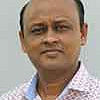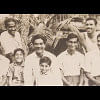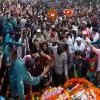When ballots countered by bullets
Dateline: Meherpur, May 13, 2005- Some workers of the local municipality were digging drains to improve the sewerage of the town. They dug up a number of skeletons including six skulls at the Puratan Dakghar area in the city. Locals told newsmen that the skeletons might be of the martyrs of the Liberation War of 1971.
Dateline: Netrokona, May 29, 2011- Family members of Abdul Hamid Talukder of Purbadhola Upazila were digging their house premises for construction work. They stumbled upon some skeletons and other remains of human bodies.
According to locals of Rajpara village the remains were of a local physician Hem Chandra Bagchi, owner of the house, and his family members who were brutally murdered and buried by Pakistan army with the help of collaborators in 1971, according to newspapers reports.
The above two incidents are just the tip of the iceberg but they testify of the brutality of the Pakistan army. The magnitude of the horrific massacre was so great that mass graves keep turning up even after so many years.
The Pakistan army turned the entire Bangladesh into a killing field with its indiscriminate killing, torture of innocent people and unprecedented scale of rapes for nine months.
After independence, mass graves were identified in the capital and other major cities and small towns.
Still, many mass graves in district and upazila levels remain unidentified, said freedom fighters and researchers.
Habibur Rahman Habib, commander of Pabna district Muktijoddha Sangsad, say they identified around 300 mass graves in the district.
Even a few years ago when a team of the investigation agency visited Pabna to collect evidences against war criminal Matiur Rahman Nizami of Pabna who led the infamous Al-Badr force, some more mass graves were identified in the district, he said.
"There may be many more small mass graves that remain unidentified yet," he said.
In view of freedom fighter Mir Abdul Hannan, unit commander of Feni district Muktijoddha Sangsad, many mass graves in his district still remain unidentified.
According to War Crimes Facts Findings Committee there are about 5000 large scale mass graves resulting from atrocities and indiscriminate killing of Pakistani military force.
"We have identified around 1000 mass graves," said Dr. M A Hasan, convener of the committee.
Hasan himself joined a team to excavate some genocide spots in 1999, 37 years after the barbaric massacre. They examined about 196 sites of mass graves and genocide remains.
He said about 30 percent of the victims were buried while rest of the bodies had been dumped into rivers, ponds, wells, and marshlands. So, numerous bodies had been washed away or remained undiscovered, he said.
Turned into killing machine, the Pakistani army continued the genocide for nine months for the total annihilation of Bangalis, causing the biggest ever humanitarian catastrophe after World War-II. They killed 30 lakh people and violated two lakh women and children.
"The Pakistan Army's brutal actions, which began on the midnight of March 25, 1971, can never be condoned or justified in any way. The army's murderous campaign in which many thousands of innocent people including women, the old and sick, and even children, were brutally murdered … constituted a measureless tragedy … The results in human suffering were beyond description," says an excerpt from the book "The Last Days of United Pakistan" written by G W Choudhury, a minister of Gen Yahya Khan.
Why did the Pakistan army commit the genocide? In the first general election held in December 1970, twenty four years after the creation of Pakistan, Bangalis used ballots against the oppression of the Pakistani rulers since 1947 and won a majority in the polls.
But the Pakistani military junta was hell bent not to handover power to the Bangalis. They made a secret plan accordingly to accomplish their mission to hold on to power.
Thus, Operation Searchlight was conceived in a meeting between two generals on March 18 when Gen Yahya Khan was holding a deceptive talk with Bangabandhu Sheikh Mujibur Rahman.
In the evening of March 25, Yahya, as planned, secretly flew out of Dhaka for Karachi via Colombo on a Pakistan International Airlines flight, ordering his marauding army to write a dark episode of world history.
A DARK NIGHT IN FLAMES
Major General Khadim Hussain Raja was brooding over the possible outcome of political talks on March 25, 1971 in Dhaka when his green telephone rang at about 11am. Lt. Gen Tikka Khan was on the line.
Tikka said, "Khadim, it is tonight,'" wrote Brigadier General Siddik Salik who was the public relations officer, then a major in the Pakistan army, in his book "Witness to Surrender."
There was no written order, only a phone call to start the annihilation of a nation.
Tanks rolled out of the cantonment firing cannons and machine gunning the sleeping civilians of Dhaka.
"The city wrapped in starlight, was in deep slumber. The night was as pleasant as a spring night in Dacca could be. The setting was perfect for anything but a bloody holocaust," wrote Salik.
The action started with the arrest of Bangabandhu. The message came on the wireless: "BIG BIRD IN THE CAGE -- OTHERS NOT IN THEIR NESTS -- OVER …"
Salik writes: "… the city of Dacca was in the throes of a civil war. I watched the harrowing sight from the verandah for four hours. The prominent feature of this gory night was the flames shooting to the sky. At times, mournful clouds of smoke accompanied the blaze but soon they were overwhelmed by the flaming fire trying to lick at the stars. The light of the moon and the glow of the stars paled before this man-made furnace. The tallest columns of smoke and fire emerged from the university campus…."
An army captain reported on the wireless that he was facing resistance from Iqbal Hall and Jagannath Hall of Dhaka University.
"A senior staff officer snatched the hand-set from me and shouted into the mouth piece: 'How long will you take to neutralize the target? -- Four hours! -- Nonsense -- What weapons have you got? -- Rocket launcher, recoilless rifles, mortars and -- O. K., use all of them and ensure complete capture of the area in two hours'," Salik wrote.
GENOCIDE IN THEIR OWN ACCOUNTS
General Tikka Khan, known as the Butcher of Baluchistan, was made the chief of Eastern Command in East Pakistan with the assignment to execute the ruthless annihilation of a people.
He delivered on the expectations of his boss and was later made governor of East Pakistan.
"I want the land and not the people, Tikka has issued orders to his troops," General Amir Abdullah Khan Niazi who later took over the war from Tikka wrote in his book "The Betrayal of East Pakistan".
"Tikka resorted to the killing of civilians and scorched-earth policy," Niazi wrote. "These orders were carried out in letter and spirit by Major General Farman and Brigadier Jahanzeb Arbab in Dhaka."
Niazi in his book mentions how Major Gen Rao Farman, who was responsible to carry out killings in Dhaka city, had envisioned his plan.
Niazi writes: "Major Gen Rao Farman had written in his table diary, 'Green land of East Pakistan will be painted red'. It was painted red by Bengali blood."
General Niazi, who took over command from Tikka Khan in April and continued the killings, himself described the March 25 genocide as follows: "General Tikka Khan struck. Peaceful night was turned into a time of wailing, crying and burning. General Tikka let loose everything at his disposal as if raiding an enemy, not dealing with his own misguided and misled people. The military action was a display of stark cruelty more merciless than the massacres at Bukhara and Baghdad by Changis Khan and Halaku Khan or at Jallianwala Bagh by the British General Dyer."
While describing the use of excessive force on the night of 25 March, one Brigadier Shah Abdul Qasim told the Hamoodur Rahman Commission that "no pitched battle was fought on the 25th of March in Dacca. Excessive force was used on that night. Army personnel acted under the influence of revenge and anger during the military operation."
Set up by the Pakistan government after its defeat in 1971, the commission noted that mortars were used to blast two residential dormitories of the Dhaka University, thus causing excessive casualties.
Gen Niazi who blamed Gen Tikka Khan for the massacre in the night of March 25, however, continued the genocide until the surrender of the Pakistan army on December 16, 1971.
Lt Col Aziz Ahmed Khan, a Pakistan army officer, who fought the 1971 war in Bangladesh, what was then East Pakistan until 26 March, 1971, went to the Hamoodur Rahman Commission and testified how the commander of the Pakistan army Lt Gen Niazi had ordered genocide.
"General Niazi visited my unit at Thakurgaon and Bogra," Aziz said in his deposition. "He asked us how many Hindus we had killed. In May, there was an order in writing to kill Hindus. This order was from Brigadier Abdullah Malik of 23 Brigade."
Looting also became the order of the day for the morally bankrupt Pakistan army.
Gen Niazi, as Maj Gen Farman Ali told the commission, on the very first day he took over command from Gen Tikka Khan said: "What have I been hearing about shortage of rations? Are not there any cows and goats in this country? This is enemy territory. Get what you want. This is what we used to do in Burma."

 For all latest news, follow The Daily Star's Google News channel.
For all latest news, follow The Daily Star's Google News channel. 








Comments